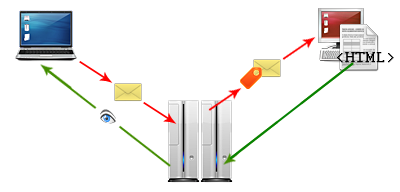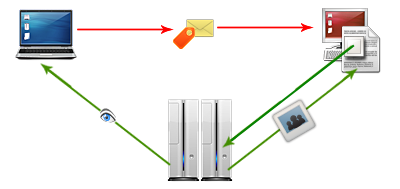5
Why forcing a receipt on your emails doesn’t really work
No comments · Posted by Bogdan in Email & Outlook
Tags: delivery notification · email read receipt · gmail read receipt · outlook read email · read notification
Let’s face it: we all want to be in control; we want to know what is happening, who does what and when! This is the likely cause of why we continually receive emails from users inquiring about how to enforce a read receipt on all outgoing emails or asking us to include this feature ASAP. We would really like to tailor this request, but unfortunately it’s not possible: there is no way that the sender of an email can know for sure who read the email, who opened it, when and so on… it’s like asking us to include a feature in Bells&Whistles so that you know what the person on the other end is wearing!
But what about those email read receipts promised by so many websites?
Yes, there are services that boast this ability but the truth of the matter is that they are mostly unreliable (or at least nowhere near 100% accurate), and can even damage your image and reputation by making you look “sneaky”. If you’ve wondered what a read receipt actually is and how it works, if someone ever told you that they received a read receipt from you even if you haven’t allowed any, then read on to know what’s what!
 A read receipt is nothing more than an alert – you send something and you get notified of it, as simple as that. Just like you can opt for a delivery notice when you mail a package with the Post Office, so too can you choose with an email (actually, with an email you can be notified of its delivery status and “Read” state). Normally, if the mail server didn’t reject the email (because its address was spelled wrong or for other reasons) and you haven’t received messages from a postmaster or MailerDaemon then it most likely was delivered.
A read receipt is nothing more than an alert – you send something and you get notified of it, as simple as that. Just like you can opt for a delivery notice when you mail a package with the Post Office, so too can you choose with an email (actually, with an email you can be notified of its delivery status and “Read” state). Normally, if the mail server didn’t reject the email (because its address was spelled wrong or for other reasons) and you haven’t received messages from a postmaster or MailerDaemon then it most likely was delivered.
Now, here’s the interesting part: to actually know when someone clicks and opens an email, you will have to have a “trigger” – Outlook, for example, inserts a special tag in the email header that sends back a notification, telling that the email was opened (Outlook knows this because the email’s status changed from NEW to Opened/Read). Since recipients can always choose not to send confirmations, this method isn’t always dependable. This is how most email clients do it, and it’s actually included in the email header Standards (although most ISPs automatically disable it – [source]).

I already know about Outlook’s read receipts. How do the others do it?
It’s actually very simple, the other services usually just insert “stuff” in emails so they get notified when someone accesses them (if an email is opened, then it’s likely been read – under this assumption, they send you a read receipt). Here are two main methods:
1) They bypass your emails through their servers and insert a special “tag” (HTML code actually) in the body of your emails, so that once the email is opened that code is ran and their servers get notified. Then, they send you a read receipt and inform you that the message has been opened.

2) a. They make you install a “wonderful, non-intrusive blabla” program on your computer that inserts HTML code in your outgoing emails. Now, the read receipt either gets delivered to their servers and then passed on to you, or you receive a read receipt directly on your computer.
2) b. They insert an image in your emails (usually it’s just a small, white square near the end of the email, but it can be anything – even the picture in the email signature). The image is hosted on their servers, so when the email is opened the image gets downloaded and they see that someone accessed it – hence, you receive a read receipt.

I stated above that these services aren’t very reliable. This is because you must always send your emails in HTML format (no plain text here) and Outlook usually asks recipients if they want to download external content when opening emails – so, that image may not even be downloaded by some of your recipients. In addition, if you’re sending emails to people in corporate offices then your emails may not even reach them because of the extra code added, being blocked at the server level.
Why? You know what else accesses sites without your explicit knowledge, or downloads content from external servers in the background? Viruses, Trojans and other malware! The web’s full of them, most Spam emails contain them and any respectable antivirus alerts you as soon as this type of behavior is encountered. Of course, the actual tags, lines of code, images or whatnot that make up the read receipt trigger aren’t doing anything malicious, but antiviruses will be alerted and email servers will block them nonetheless.
Of course, you may just want to be sure about your important emails’ statuses or have something “at-hand” for special cases. Unfortunately, delivery and read receipts don’t hold any ground in court. In cases where, for example, your phone company states they didn’t receive your payment and calls you in court a lawyer or judge can issue an order to investigate your communication on their servers.
In addition, take into consideration that enforcing a read receipt on someone who doesn’t know about it may be regarded as violation of privacy. This, combined with the drastic increase of an email server regarding your message as Spam, the fact that it doesn’t work that well (or not at all) for web-based email clients (Gmail, AOL, Hotmail, Yahoo etc.) makes for a pretty convincing case against enforcing read receipts.
In the end, if you still want to use read receipts and don’t know where to start, you can always try the default ones in Outlook. If you want to use read receipts with Gmail, then you will just have to sign up for their Google Apps services which include read receipts in addition to many others – both of these are ok, accepted by email servers worldwide and safe. Also, there are quite a number of services that will hassle your recipients for free, so at least try one of those before! 🙂
If you want more control over your emails you can also take a look at our products here. They have tons of features and will always be safe – we never liked the idea that someone else can insert “stuff” in our emails and developed our add-ins for Outlook accordingly!
If you have ever sent out an email newsletter, I’m sure that with each passing campaign you encountered people who opted out of your email list. Have you ever asked yourself why? Read more: Why do people unsubscribe to emails? | 1 Comment
The subject line in an email, almost as much as the from line, is one of the most important deal-breakers for your readers. That’s why this week we looked at how different email clients (on all platforms we could get our hands on) dealt with them… So, continue reading and see for yourself how many characters your subject line should have! Read more: The maximum displayed length of the email subject line | 1 Comment
In last week’s article, we hoped to convince you that the from line is at least as important as the subject line in all your email communications. Now, to help you out, we tested different platforms and came up with the following “cheat-sheet”, detailing the maximum displayed length of the from line on different browsers, phones and desktop applications! Read more: The maximum displayed length of the email from line | 2 Comments
No comments yet.
<< The best email fonts are the ones already included in Outlook!
